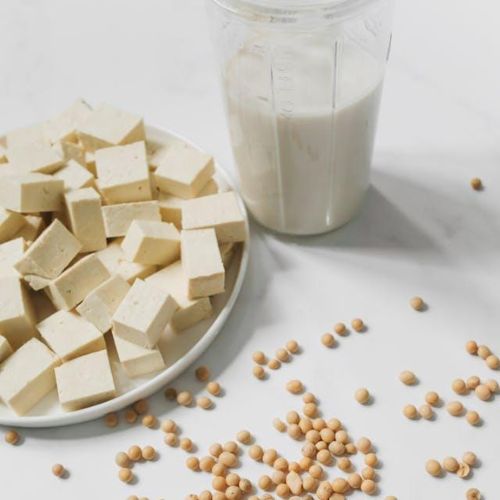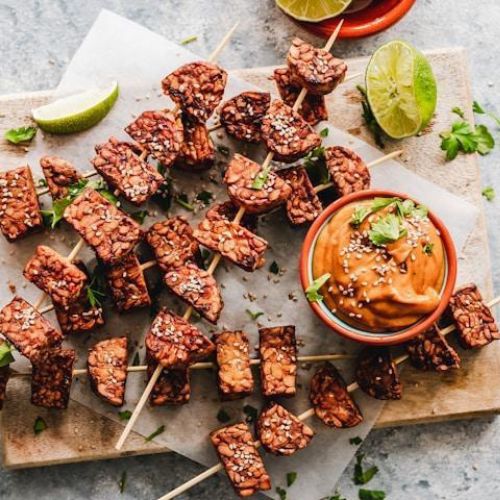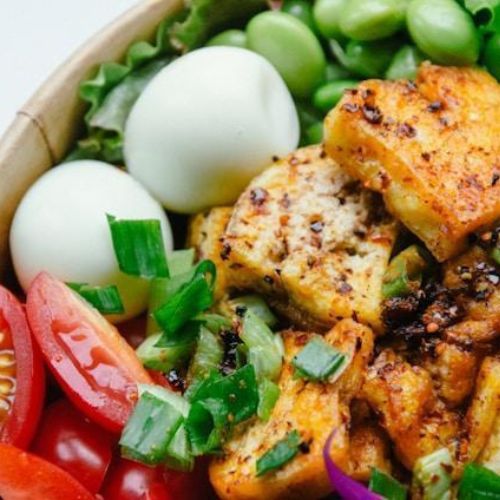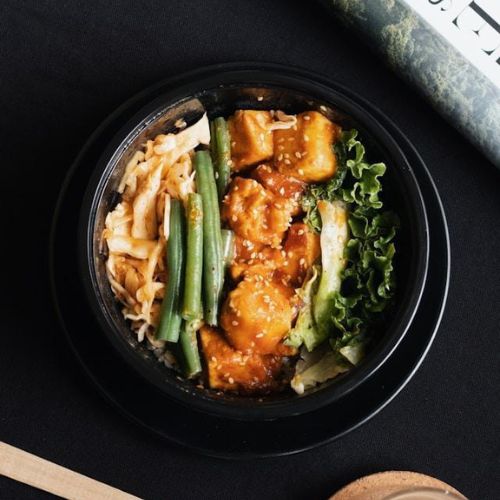If you’re on the hunt for a protein-packed, flavourful ingredient to elevate quick vegan meals in a flash, look no further than tempeh.
From its hearty texture to its versatility in the kitchen, tempeh is stealing the spotlight from its soy-based cousin, tofu. Here’s why…
But First, Tempeh vs Tofu: What are the Main Differences?

Tempeh and tofu primarily differ in their texture, taste and production. While both are soy-based, tofu or bean curd has a soft and smooth texture, like custard or cheese. Tempeh has a firmer, denser and chewy texture and a slightly nutty taste than tofu.
While tofu is neutral flavoured, tempeh is nuttier, similar to a veggie burger or nutty whole grain. Tofu is derived from curdling fresh soy milk and then pressing the resulting curds into blocks.
Soy milk is typically coagulated with calcium sulphate or magnesium chloride. The resulting curd is pressed into various textures, ranging from soft silken tofu to firm tofu.
On the other hand, tempeh is made by fermenting cooked soybeans with a starter culture called Rhizopus oligosporus. The fermentation process binds the soybeans into a dense cake-like block, creating a nutty flavour and firm texture.
Sometimes other grains, such as barley or rice, may be added to the soybeans before fermentation. Doing so adds a depth of flavour and texture.
#1. Tempeh Packs a Protein Punch

With around 20 grams of protein for every 100 grams (compared to regular tofu’s 8 grams per 100 grams*), tempeh is a protein powerhouse ingredient that will keep you feeling satisfied and energised throughout the day. If you’re all about that protein power, tempeh has your back.
*Raw silken tofu contains 6.9g of protein per 100g while raw firm tofu contains 17.3g of protein per 100g.
#2. Tempeh Is a Textural Wonder

Among the things that sets tempeh apart from tofu is its unique texture. Made from fermented soybeans, tempeh has a slightly nutty flavour. Unlike soft and squishy tofu, tempeh boasts a firmer texture. Combined, these features add depth and substance to any dish.
Additionally, the firm texture of tempeh holds up beautifully in stir-fries, sandwiches, and salads. But, whether you’re crumbling it into tacos, slicing it for sandwiches, or marinating it for a barbecue, tempeh brings a satisfying bite that tofu simply can’t match.
#3. Tempeh Requires Minimal Prep

When you’re short on time but still craving a delicious and nutritious meal, tempeh is your secret weapon. Unlike tofu, which often requires pressing and marinating to achieve optimal flavour and texture, tempeh is ready to go straight out of the packet.
Simply slice, dice, or crumble it into your dish of choice and you’re good to go — no fuss, no hassle, just pure plant-based goodness. Tempeh’s firmer texture also makes it less prone to crumbling or breaking apart during cooking than tofu.
This means you can handle tempeh more vigorously without worrying about it falling apart, making it ideal for quick sautés, stir-fries, or grilling where you need ingredients to hold their shape.
#4. Tempeh Absorbs Flavours Like a Boss

One of the things that makes tempeh so versatile in the kitchen is its ability to absorb marinades, sauces and spices like a sponge. Whether you’re craving tangy barbecue, zesty lemon, or spicy curry, tempeh is the perfect canvas for all your favourite flavours.
Simply marinate it for a few minutes or toss it in your sauce of choice and watch as it transforms into a flavour-packed delight that will tantalise your taste buds.
#5. Tempeh Needs Less Seasonings

Tempeh also packs sufficient flavour on its own – adding to its quick meal advantage. Unlike tofu, which often requires marinating or seasoning to enhance its flavour, tempeh boasts a robust taste. It has a naturally nutty and savoury taste that shines through with minimal seasoning.
A simple marinade or sauce is all you need to enhance tempeh’s flavour profile and create delicious meals in no time. This makes tempeh an excellent choice for quick and fuss-free cooking, especially on busy weeknights or hectic days.
#6. Tempeh Offers Versatility

Tempeh’s firm texture lends itself well to crisp up in a hot pan or oven, creating deliciously golden-brown edges and a satisfying crunch. Whether you’re making tempeh bacon, crispy nuggets, or seared slices for a sandwich, tempeh’s texture allows it to develop a crispy exterior quickly.
It also adds depth of flavour and texture to your meals without extra time or effort. Further, tempeh’s nutty flavour and firm texture make it ideal for grilling, sautéing and baking.
You can also crumble it into dishes like stir-fries, sandwiches, burgers, salads and grain bowls. It adds a hearty and chewy texture to dishes and absorbs flavours well.
#7. Tempeh Cooks Fast

Because tempeh is already fermented and has a dense texture, it requires less cooking time compared to tofu.
While tofu may need to be cooked for longer periods to achieve the desired texture and flavour, tempeh cooks relatively quickly. It is perfect for time-sensitive meals when you need to get food on the table fast.
#8. Tempeh Offers Nutritional Benefits

In addition to its protein richness, tempeh is also packed with beneficial nutrients that support overall health and well-being. It’s a good source of fibre, iron, calcium and various vitamins and minerals, making it a nutritious addition to any vegan diet.
Plus, since it’s fermented, tempeh contains probiotics that promote gut health and digestion — talk about a win-win!
#9. Tempeh Is Environmentally Friendly
If you’re passionate about sustainability and reducing your environmental footprint, tempeh is a great choice for your plant-based meals. Tofu requires significant water and energy inputs for production.
On the other hand, tempeh production is more environmentally friendly and resource-efficient. Some studies even suggest that tempeh by-products can be used to formulate NPK-rich fertiliser to naturally grow even more plants.
By choosing tempeh over tofu, you’re not only nourishing your body but also supporting eco-friendly food practices.
Unlocking the Deliciousness of Tempeh
With its protein-packed goodness, textural wonders, minimal prep requirements and nutritional benefits, tempeh is the ultimate kitchen companion for those seeking flavourful and satisfying plant-based eats.
Whether you’re a seasoned vegan or a hopeful newbie, tempeh is sure to take your culinary adventures to new heights. So go ahead, grab a packet of tempeh and let your taste buds rejoice in the delightful world of plant-based deliciousness!

Really intrigued by the texture capabilities of tempeh mentioned. Does anyone have tips for achieving the best texture? Haven’t had much luck in my past attempts.
While I appreciate the enthusiasm for tempeh’s environmental benefits, it’s crucial to also consider the whole lifecycle of soy production. Isn’t comparing it to tofu somewhat limited given they’re both soy-based products?
Good point, Mike. It’s all about the bigger picture. But it’s still great to see more sustainable options being discussed and appreciated.
totally here for the protein punch. gym life means protein is key. anyone else use tempeh as a post-workout snack?
All this hype around tempeh but nothing beats a good ol’ cheeseburger, does it? Can’t imagine it tastes near as good.